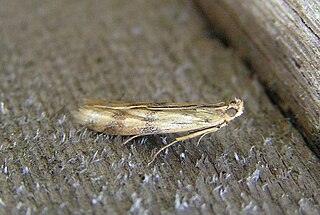
Arta is a city in northwestern Greece, capital of the regional unit of Arta, which is part of Epirus region. The city was known in ancient times as Ambracia. Arta is known for the medieval bridge over the Arachthos River. Arta is also known for its ancient sites from the era of Pyrrhus of Epirus and its well-preserved 13th-century castle. Arta's Byzantine history is reflected in its many Byzantine churches; perhaps the best known is the Panagia Paregoretissa, built about 1290 by Despot Nikephoros I Komnenos Doukas. The city is the seat of the Technological Educational Institute of Epirus.

Artas is a commune in the Isère department in the Auvergne-Rhône-Alpes region of south-eastern France.
Micromartinia is a genus of moths of the family Crambidae. It contains only one species, Micromartinia mnemusalis, which is found in Costa Rica, Brazil, French Guiana and Venezuela.

Homoeosoma sinuella is a moth of the family Pyralidae. It is found in Europe.
Anassodes is a monotypic snout moth genus. It was described by Alfred Jefferis Turner in 1932, and contains the species Anassodes mesozonalis. It is found in Australia, including the type location of Western Australia.
Anemosa is a genus of snout moths. It was described by Francis Walker, in 1859, and is known from Australia.
Anemosella is a genus of snout moths. It was described by Harrison Gray Dyar Jr. in 1914.
Anemosella basalis is a species of snout moth. It is found in Mexico and the US state of Arizona.
Arouva is a genus of snout moths. It was described by Francis Walker in 1864.

Arta statalis, the posturing arta moth, is a species of snout moth in the genus Arta. It was described by Augustus Radcliffe Grote in 1875 and is the type species of its genus. It is found in North America including Delaware, Florida, Georgia, Illinois, Iowa, Massachusetts, New Jersey, New York, North Carolina, Oklahoma, Pennsylvania, South Carolina, Tennessee and Virginia.
Azamora is a genus of snout moths. It was described by Francis Walker in 1858, and is known from Venezuela, Brazil, Suriname, and French Guinea.
Bonchis is a genus of snout moths. It was described by Francis Walker in 1862, and is known from Trinidad and Brazil.
Caphys bilineata is a species of snout moth. It was described by Caspar Stoll in 1781. It is found in much of South America, including Suriname, Honduras, the West Indies, Venezuela and Brazil.
Azamora bilinealis is a species of snout moth in the genus Azamora. It was described by Hans Georg Amsel in 1956, and is known from Venezuela.
Bonchis munitalis is a species of snout moth in the genus Bonchis. It was described by Julius Lederer in 1863, and is known from Honduras, the Dominican Republic, Brazil and Venezuela. It is also found in the southern United States.

The Phycitini are a tribe of moths of the family Pyralidae.

The Anerastiini are a tribe of moths of the family Pyralidae.
Arta is a highly endangered Negrito language of the northern Philippines.
Dicepolia artoides is a moth in the family Crambidae. It was described by James E. Hayden in 2009. It is found on the eastern slopes of the Andes from Bolivia to Venezuela. It has also been recorded from French Guiana.





